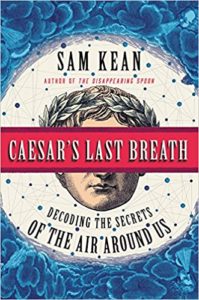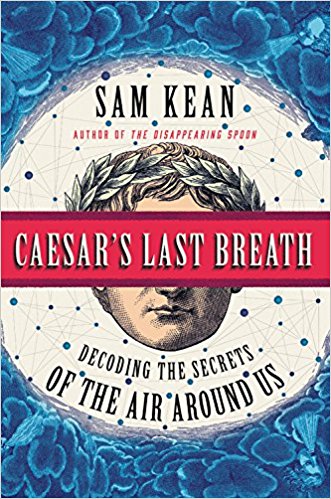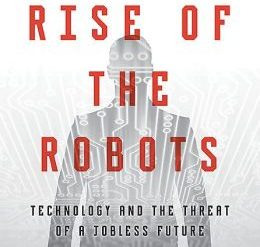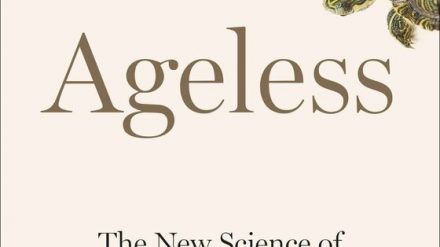
Ever heard of dichlorodifluoromethane? (That’s CCl2F2 to you chemistry students.) Well, guess what? You inhale seven trillion molecules of the stuff every time you breathe. Yes, it’s in the air we breathe. That’s just one of the lesser revelations in Sam Kean’s eye-opening and thoroughly enjoyable new survey, Caesar’s Last Breath: Decoding the Secrets of the Air Around Us.
As the title will suggest to the careful reader, the central conceit in Kean’s book is that “roughly one particle of [the last breath Julius Caesar took after he was stabbed] will appear in your next breath.” Apparently, this “how-many-molecules-in-X’s-last-breath exercise has become a classic thought experiment in physics and chemistry courses.” Not in mine, though. I don’t remember much about those courses, but I’m sure I would’ve remembered that.
A fascinating history of the air we breathe
In Caesar’s Last Breath, Kean will take you on a fast ride through the 4.5-billion-year history of Earth’s atmosphere and then through the more than one hundred different gases that comprise the atmosphere today. Yes, more than one hundred. Individual chapters—and “interludes” placed between them—tell tales about each of the major substances. Everybody knows about nitrogen, oxygen, and carbon dioxide. But there’s also carbon monoxide (CO), nitrous oxide (N2O, known as laughing gas), methanethiol (CH3SH), and all manner of others. However, this is no mind-numbing laundry list of unfamiliar substances. Kean uses each one as a lever into the history of atmospheric science. And along the way he strays—delightfully—into topics that may be only tangentially related to the air we breathe.
Caesar’s Last Breath: Decoding the Secrets of the Air Around Us by Sam Kean ★★★★★
A book about the scientists who uncovered the story
In fact, Caesar’s Last Breath is as much about the scientists, famous and not, whose discoveries over the centuries have helped us understand the nature and the effects of each of the major gases in our atmosphere. If you’re at all familiar with the history of science, you’ll recognize the names Fritz Haber, Joseph Priestley, Antoine-Laurent Lavoisier, Robert Boyle, Henry Cavendish, Humphry Davy, and so many others who have made the world around us easier to understand. Don’t think for a minute, though, that Kean simply offers up the usual dry recitation of each scientist’s discovery and how he made it. No. Instead, the author tells us things we never knew, or at least things that I never knew, about these fascinating people.
For example, here are four of the fascinating stories about the scientists involved in studying the air we breathe:
- Henry Cavendish, the man who discovered hydrogen, was autistic and “communicated with his domestic staff via notes.” He was also filthy rich. “During his lifetime, Cavendish had more money in the Bank of England than any other British subject.”
- Joseph Priestley, the co-discoverer of oxygen, was a Protestant minister whose investigations prompted a mob in Birmingham to burn down his church and his home, hoping (without success) to see him burn inside it.
- Antoine-Laurent Lavoisier, who tried to take sole credit for the discovery of oxygen, was an aristocrat who went to his death on the guillotine in the French Revolution. Lavoisier had been a rapacious tax-collector, and if anybody deserved such a fate, he probably did.
- And Albert Einstein teamed up with fellow nuclear physicist Leo Szilard to invent a better refrigerator. (They actually invented several and made a pile of money from them.)
You’ll also meet people whose names you’re highly unlikely to know but will probably never forget, including the man who proved why the sky is blue, “the worst poet who ever lived,” and Le Pétomaine (the Fartomaniac), who became the highest-paid performer in France for his wildly popular act in which he sang and did impressions by passing gas.
Fascinating and sometimes hilarious sidelights
Caesar’s Last Breath is full of fascinating and sometimes hilarious sidelights such as these. For example, did you know that “[B]efore 1850 people routinely committed suicide rather than face surgery?” (I didn’t, and I’ve read a bit about the history of medicine.) It was only in the mid-19th century that anesthetics—first nitrous oxide, then ether, and finally chloroform—finally started coming into use.
Sam Kean‘s writing style is informal, to say the least. (I don’t think I’ve ever seen the word “catookus” in print anywhere else.) You can easily imagine him talking to you and laughing pretty much half the time. Given the aridity of so much of typical science histories, Caesar’s Last Breath is a delight.
For related reading
I’ve also reviewed Sam Kean’s The Bastard Brigade: The True Story of the Renegade Scientists and Spies Who Sabotaged the Nazi Atomic Bomb (The secret mission to stop the Nazi atomic bomb).
You might also enjoy Science explained in 10 excellent popular books.
If you enjoy reading nonfiction in general, you might also enjoy:
- Great biographies I’ve reviewed: my 10 favorites
- My 10 favorite books about business history
- 20 top nonfiction books about history
And you can always find my most popular reviews, and the most recent ones, on the Home Page.



























